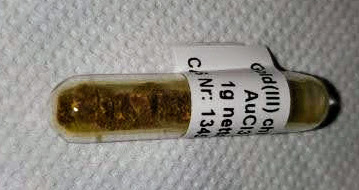Gold(III) chloride
Gold(III) chloride, traditionally known as auric chloride, is a chemical compound of gold and chlorine. With the molecular formula AuCl3, it is a yellow-orange solid. Gold(III) chloride is a common starting material in gold chemistry, particularly in the formation of gold-based catalysts and as a precursor to gold nanoparticles.
Properties[edit | edit source]
Gold(III) chloride is highly soluble in water, where it forms acidic solutions. It can also dissolve in ethanol and acetone. When heated, gold(III) chloride decomposes to gold(III) oxide and chlorine gas. In its solid form, it exists in two polymorphs: a stable form with a monoclinic crystal structure and a metastable form with an orthorhombic crystal structure.
Synthesis[edit | edit source]
Gold(III) chloride can be synthesized by reacting gold with chlorine at elevated temperatures. Another method involves the chlorination of gold in the presence of aqua regia (a mixture of nitric acid and hydrochloric acid), which dissolves gold to form chloroauric acid (HAuCl4). The chloroauric acid can then be reduced to gold(III) chloride by heating or by adding a less noble metal such as sodium metabisulfite.
Applications[edit | edit source]
Gold(III) chloride is used in organic synthesis as a catalyst for reactions such as the cyclization of alkynes and the hydration of alkynes to ketones. It is also employed in the preparation of gold nanoparticles and in the decoration of ceramics and glass. In medicine, gold(III) chloride has been explored for its potential anti-cancer properties, though its use is limited due to its toxicity.
Safety[edit | edit source]
Gold(III) chloride is toxic if ingested, inhaled, or if it comes in contact with skin. It can cause severe irritation to the skin, eyes, and respiratory system. Appropriate safety measures, including the use of personal protective equipment, should be taken when handling this compound.
See also[edit | edit source]
Search WikiMD
Ad.Tired of being Overweight? Try W8MD's physician weight loss program.
Semaglutide (Ozempic / Wegovy and Tirzepatide (Mounjaro / Zepbound) available.
Advertise on WikiMD
|
WikiMD's Wellness Encyclopedia |
| Let Food Be Thy Medicine Medicine Thy Food - Hippocrates |
Translate this page: - East Asian
中文,
日本,
한국어,
South Asian
हिन्दी,
தமிழ்,
తెలుగు,
Urdu,
ಕನ್ನಡ,
Southeast Asian
Indonesian,
Vietnamese,
Thai,
မြန်မာဘာသာ,
বাংলা
European
español,
Deutsch,
français,
Greek,
português do Brasil,
polski,
română,
русский,
Nederlands,
norsk,
svenska,
suomi,
Italian
Middle Eastern & African
عربى,
Turkish,
Persian,
Hebrew,
Afrikaans,
isiZulu,
Kiswahili,
Other
Bulgarian,
Hungarian,
Czech,
Swedish,
മലയാളം,
मराठी,
ਪੰਜਾਬੀ,
ગુજરાતી,
Portuguese,
Ukrainian
Medical Disclaimer: WikiMD is not a substitute for professional medical advice. The information on WikiMD is provided as an information resource only, may be incorrect, outdated or misleading, and is not to be used or relied on for any diagnostic or treatment purposes. Please consult your health care provider before making any healthcare decisions or for guidance about a specific medical condition. WikiMD expressly disclaims responsibility, and shall have no liability, for any damages, loss, injury, or liability whatsoever suffered as a result of your reliance on the information contained in this site. By visiting this site you agree to the foregoing terms and conditions, which may from time to time be changed or supplemented by WikiMD. If you do not agree to the foregoing terms and conditions, you should not enter or use this site. See full disclaimer.
Credits:Most images are courtesy of Wikimedia commons, and templates, categories Wikipedia, licensed under CC BY SA or similar.
Contributors: Prab R. Tumpati, MD


